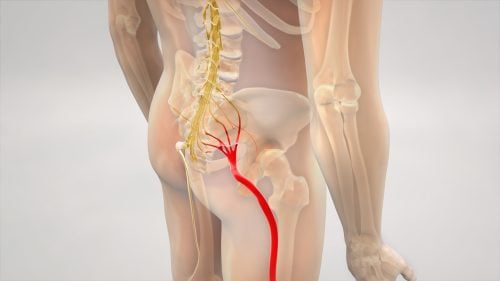

What is Sciatica?
Sciatica is a condition or symptom caused by underlying factors. It is not a disease in itself. The sciatic nerve is a major nerve that enervates the legs, buttocks, and lower back. It is the longest single nerve root in the body. The origin of the sciatic nerve is in the spinal cord, from where it runs down to the lower back and sends nerve endings down the lower limbs.
Pinching or pressure on the sciatic nerve causes pain that radiates down all the organs innervated by the sciatic nerve. This sciatic pain usually originates in the lower back, moving down the lower limbs.
Sciatica pain can be frustrating because it affects simple activities. Activities like sitting and walking can cause pain, reducing the quality of life. Sciatica pain follows the path of the sciatic nerve. So pain can start in the lower back and affect the hip down to the foot. That’s why you may have lower back pain. This can combine with burning or tingling in your buttocks or leg. Below are the most common sciatica symptoms:
- Lower back pain
- Pain in the buttocks or leg that’s worse when sitting
- Hip pain
- Burning or tingling in leg
- Weakness, numbness, or difficulty moving the leg or foot
- Constant pain through buttocks
- Difficulty standing up
Sciatica in Australia
Sciatica is a common issue in Australia, affecting many people across different age groups. According to the Australian Institute of Health and Welfare, up to 10% of Australians experience sciatica at some point in their lives. This condition is a significant contributor to chronic pain and disability, impacting the quality of life and productivity.
Diagnosing Sciatica
Physical examination will chronicle the range of movement and the sites of pain. Combined with a detailed medical history, this can help to pin down a diagnosis of sciatica. The most common neural tests in the clinic include:
- Straight leg raise test
- Crossed straight leg raise test
- Slump test
- Femoral nerve tension test
When a positive neural test combines with the description of pain radiating down one leg, this is usually enough for a positive diagnosis of sciatica.
Acupuncture for Sciatica Pain
 Acupuncture, a key component of Traditional Chinese Medicine (TCM), involves inserting fine needles into specific points on the body to stimulate healing and relieve pain. Research has shown that acupuncture can be an effective treatment for sciatica.
Acupuncture, a key component of Traditional Chinese Medicine (TCM), involves inserting fine needles into specific points on the body to stimulate healing and relieve pain. Research has shown that acupuncture can be an effective treatment for sciatica.
Research on Acupuncture for Sciatica
- Systematic Review and Meta-Analysis (2015): A systematic review and meta-analysis involving 12 studies with 1842 participants found that acupuncture was more effective than conventional Western medicine in reducing pain intensity and increasing pain threshold in patients with sciatica?.Find Journal Article here Acupuncture for Sciatica Pain ResearchMore research is needed on acupuncture for sciatica.
Multicenter Randomised Controlled Trial (2022): This trial aims to evaluate the efficacy and safety of acupuncture for chronic sciatica over a 52-week follow-up period. Preliminary results suggest that acupuncture can significantly reduce leg pain intensity and improve disability scores compared to sham acupuncture? (Hindawi)
Chinese Herbal Medicine for Sciatica
 Chinese herbal medicine is another TCM approach used when treating sciatica symptoms. Herbal formulas are tailored to the individual’s specific condition, aiming to balance the body’s energy, improve circulation, and reduce inflammation.
Chinese herbal medicine is another TCM approach used when treating sciatica symptoms. Herbal formulas are tailored to the individual’s specific condition, aiming to balance the body’s energy, improve circulation, and reduce inflammation.
Research on Chinese Herbal Medicine for Sciatica
A systematic review and Bayesian network meta-analysis protocol aims to evaluate and compare the effectiveness of various Chinese patent medicines (CPMs) for sciatica. This comprehensive review will help determine the best CPMs for treating sciatica by analyzing their clinical efficacy, pain reduction, lumbar spine function, and adverse events.
The research results will be interesting to see when completed.
What happens in an acupuncture treatment for sciatica pain relief?
At Paul Carter’s Acupuncture & Herbal Clinic, a typical treatment for low back pain may include:
- Consultation: Understanding your specific symptoms, medical history, and overall health.
- Examination: Physical assessment to identify the underlying causes of your pain.
- Personalised Treatment Plan: Acupuncture, Chinese herbs, or a combination of both, tailored to your needs.
- Follow-up Care: Regular sessions and adjustments to the treatment plan as needed.
Your comfort and well-being is Paul’s priority, and he’s here to support you every step of the way.

Booking Your Acupuncture and Chinese Herbal Sciatica Treatment Hervey Bay
Are you struggling with sciatica pain? It’s time to have acupuncture. Here’s how you can book your acupuncture and Chinese herbal treatment with me:
Step 1. Find Your Initial Appointment
Use the online booking system below to choose the best time for your initial appointment. It’s simple and convenient, allowing you to find a slot that fits your schedule.
Step 2. Complete the Online Forms
Once you’ve made your initial appointment, the online booking system will send you an email with forms to fill in before your visit. These forms help me understand your specific needs and tailor the treatment to you. It’s a crucial step in ensuring that we make the most of our time together in the clinic.
I’m Looking Forward to Seeing You Soon!
Your health and well-being are my top priorities. I can’t wait to welcome you to the clinic and start working towards pain relief. Together, we’ll take the first step towards a more comfortable and pain-free life.
See you soon,
References
- Yu, F-T., et al. (2022). “Acupuncture for Chronic Sciatica: Protocol for a Multicenter Randomised Controlled Trial.” BMJ Open.
- Ji, M., et al. (2015). “The Efficacy of Acupuncture for the Treatment of Sciatica: A Systematic Review and Meta-Analysis.” Evidence-Based Complementary and Alternative Medicine.
- An, H., et al. (2020). “Effectiveness Comparisons of Chinese Patent Medicine on Sciatica: A Protocol for Systematic Review and Bayesian Network Meta-Analysis.” Medicine.
Disclaimer: Individual Results May Vary
At Paul Carter’s Acupuncture and Herbal clinic, Paul is committed to providing quality acupuncture and Chinese medicine treatments to his clients. Paul believes in the power of these ancient practices to promote overall well-being and balance within the body.
However, it’s important to recognise that every individual is unique, and results can vary widely from person to person. While many have found relief and benefits from Paul’s treatments, Paul cannot guarantee or imply specific results for everyone.
Paul’s treatments are tailored to the individual needs and conditions of each client, and he works closely with you to develop a personalised plan. But like all medical and therapeutic practices, acupuncture and Chinese medicine may not be suitable for everyone or may not produce the desired results in every case.
Paul encourages you to consult with him to discuss your specific needs and expectations. He also recommends consulting with your primary healthcare provider to ensure that acupuncture and Chinese medicine are appropriate for your particular situation.
Remember, your journey to health and wellness is a personal one, and what works for one person may not work for another. Paul is here to support you on that journey, but he cannot promise specific outcomes.
Your trust and understanding are important to Paul, and he’s always here to answer any questions or concerns you may have.

